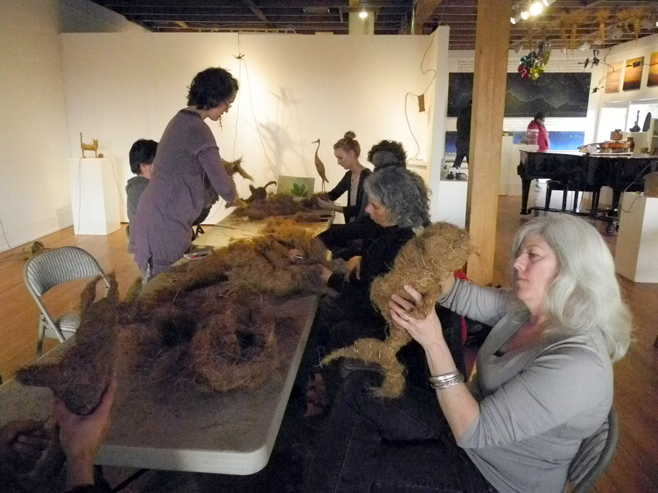In Melissa Daubert’s art installation in progress, “String Calendar,” a cord circling the room around her small sculptures started out as the rope that bound bales of coir, coconut straw mats she uses to make her whimsical figures of birds, fish, rabbits and trucks.
That cord also has another purpose: The rope connects art inspired by Daubert’s experiences during her residency at Bunnell Street Arts center since Sept. 15. It also symbolically connects Daubert to the people she has met during her visit.
The Rasmuson Foundation Artist in Residence, Daubert, of Cleveland, Ohio, stays in Homer through Nov 15. “String Calendar” opens at a reception 5 to 7 p.m. Nov. 1, with an artist’s talk at 6 p.m.
Daubert, 45, got the idea for “String Calendar” when she saw “Dena’inaq’ Huch’ulyeshi: The Dena’ina Way of Living,” an exhibit at the Anchorage Museum. The Dena’ina people, one of the largest and most widespread Alaska Native groups, marked the days in string calendars by tying knots in cords or adding beads and other objects to record special events.
“String Calendar” begins with a sculpture of the All Saints of American Antiochian Orthodox Mission off Skyline Drive, a church Daubert visited. Daubert arranges the coir — pronounced “coy-ay” — in the general shape of her piece and then wraps it with gold colored wire. The installation continues throughout the gallery.
Each work is like an entry in a travel journal. For a horse-riding trip to the head of Kachemak Bay at Fox Creek and Sheep Creek, Daubert made sculptures of horseshoes and of a fox and a sheep. Another sculpture shows the license plate of a van pushed over the bluff north of Homer that Daubert saw on a beach walk.
“Some of the experiences were extraordinary and some were mundane, but it’s helped me appreciate every moment and look at things differently,” she said.
Daubert started using coir for “Listening Man,” a sculpture she did at The Gathering Place in Beechwood, Ohio, a resource center for people with cancer. The sculpture of a man listening is used in therapy for children to talk about their feelings.
“They wanted something outside that was natural,” she said. “They wanted it to blend in with the environment.”
Researching materials, she found coir, a material used for erosion control that’s resistant to mold and bacteria.
“I figured if they use it for that, it would probably last pretty well, and yet it’s not synthetic,” Daubert said.
On her website, Daubert calls her business Interactive Works of Art. Before becoming a freelance artist, she worked 10 years as lead designer and fabricator at the Great Lake Science Center, Cleveland, helping build more than 100 exhibits.
“I like things that are educational,” she said. “A lot of times I make things that have a specific goal for a hospital, for helping people heal, for teaching.”
Another work, “Everybody’s Somebody,” would shine a spotlight on people when they walked into the sculpture and they would hear applause.
“Even though it was 1,000 sculptures and a soundtrack, it was joyful,” she said. “People left with big huge smiles on their faces.”
A friend of Daubert describes her as “an experience artist,” she said.
“The work I’m creating is an experience for a visitor, either by helping to create it or interacting with it, doing something that makes something happen that creates their experience,” she said. “I feel like there has to be some kind of goal other than something that is aesthetically pleasing.”
While Homer helped create “String Calendar” by inviting Daubert into the community and giving her cool things to do, she’s also involved the town with two public art workshops. Earlier this month citizen artists made fish sculptures that Daubert strung on a motor driven mobile. Last Saturday, people made fish sculptures of coir and wire.
At the workshop, Daubert taught us the basics. First, find a lump of coir.
“You find the right piece that speaks to you and form it into the shape you want,” she said.
Next, after mashing the coir into a fish-like thing, wrap it with wire to firm up the form. Fins and other features were then added. I made a salmon that looked more like a Frankenfish.
No, not a GMO, or genetically modified organism, said artist Lynn Naden, also in the workshop.
“CMO,” she said, “Creatively modified organism.”
Shaping the fish and binding them with wire became a playful art project. Loose strands of coconut grass littered the floor, so that afterward it looked like cut hair at a barber shop.
“It’s funny how much this feels like elementary school,” said Asia Freeman, Bunnell’s executive director, at the workshop.
Peace Corps service in Nyazura, Zimbabwe, from 1991-93 gave Daubert skills to teach people in making art. She graduated with a bachelor of fine arts in illustration from the Columbus College of Art and Design, Ohio, where she also took welding and metal fabrication. In Zimbabwe she taught children how to work with sheet metal and make things like pencil boxes, funnels, door latches and bike racks.
Children, it turns out, love Daubert’s work.
“They’re my biggest fans,” she said, “Kids are drawn to my work.”
While “String Calendar” opens on Nov. 1, Daubert’s residency extends beyond that. She’ll be teaching some classes in November, but doesn’t know if she’ll add to it. One thing she’d like to do is add a written narrative to the exhibit.
“They just think they’re cool objects, but they don’t realize there are stories behind them,” she said of each work. “For people who are part of this, I think it would be cool for them to read about how they were part of this.”
Michael Armstrong can be reached at michael.armstrong@homernews.com.
Melissa Daubert
Rasmuson Foundation Artist in Residence
Bunnell Street Arts Center
“String Calendar” art installation
First Friday reception, 5-7 p.m. Nov. 1
Artist’s talk, 6 p.m.
www.melissadaubert.com


